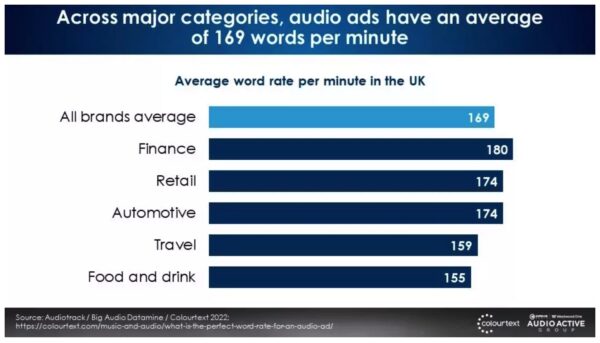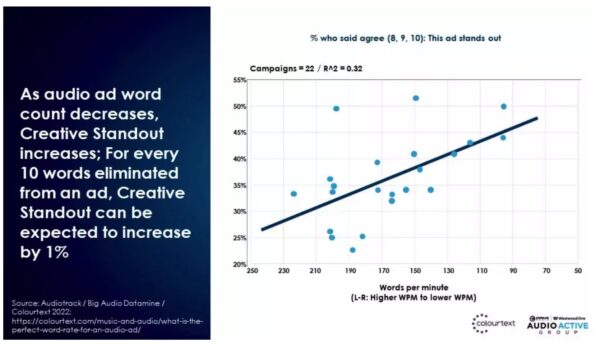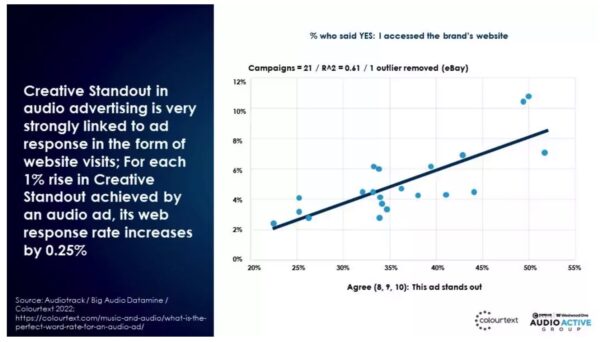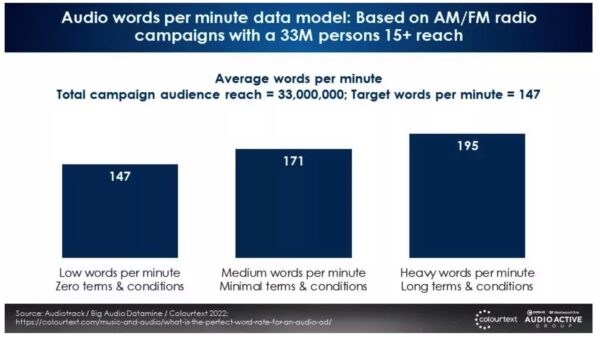Less Is More: Reduce Audio Ad Copy Word Count And Improve Effectiveness
November 17, 2023

By Pierre Bouvard
Jason Brownlee, Founder of the UK analytics firm Colourtext, studied the impact of word density on the effectiveness of audio advertising in his blog originally published for Colourtext. His research found cutting words from audio copy improves brand effect and grows site traffic.
A major new study finds the lower the audio word count per minute, the greater the brand standout, which in turn increases campaign web response. Two major findings:
- Eliminating 10 words of audio copy increases the Creative Standout score by 1%. Creative Standout is achieved when consumers say “this ad stands out” and rate an ad with an 8, 9, or 10 on a one to ten standout scale.
- Eliminating 10 words of audio copy increases web traffic by 0.25%. Creative Standout in audio advertising is strongly linked to ad response via website visits. For each 1% rise in audio ad Creative Standout, website response rate increases by 0.25%.
How the study was conducted
Several firms collaborated to produce this first of its kind study that examined thousands of campaigns.
Audiotrack is a UK audio distribution service that sends ads from creative agencies to audio publishers. Audiotrack delivers audio ads to all UK and Republic of Ireland radio stations, digital streaming, and podcast platforms.
Colourtext, a leading media analysis firm, examined over 10,000 campaigns that aired between 2019 and 2021. Activity included 615 national brands across 22 advertiser categories. Audiotrack text-transcribed approximately 70% of these advertisements.
Major finding: Word density (expressed as words per minute) has a major impact on the effectiveness of audio ads
The average number of words per minute used in UK audio commercials is 169. This can vary widely from just 155 words per minute in the food and drink sector to 180 words per minute on average for financial brands.

Methodology: To examine the impact of word density, Colourtext fused the Audiotrack database to 1,000 advertising effectiveness studies conducted by Radiocentre, the UK’s AM/FM radio advertising industry organization. Click here for a summary report on the five key findings from Big Audio Datamine, which analyzed the massive archive of the 1,000 Radioguage advertising effectiveness studies.
There were 22 transcribed AM/FM radio campaigns that aired between 2020 and 2022 that are common to both datasets. Colourtext analyzed the relationship between word density and audio advertising effectiveness of the campaigns.
Radiogauge campaign effectiveness studies measure a wide range of brand equity and advertising creative diagnostics. Creative Standout was found to be the metric that’s most sensitive to variations in word count.
Less is more: The fewer words used in an ad, the more it will stand out and be effective; For every 10 words per minute eliminated from an ad, Creative Standout can be expected to grow by 1%

The visual above reveals as the word density (words per minute) of an audio ad increases, its Creative Standout falls.
- Each 1% rise in audio ad Creative Standout results in a web response rate increase of 0.25%
Colourtext found Creative Standout in audio advertising is very strongly linked to ad response in the form of website visits. This regression plot demonstrates that for each 1% rise in Creative Standout achieved by an audio ad, its web response rate can be expected to increase by 0.25%.

Campaign effect of copy with light, medium, and heavy word count
A data model was built to understand the practical effects of word density and Creative Standout in audio advertising. Three ranges of word count per minute are examined: light (147 words per minute), medium (171), and heavy (195 words per minute). Campaigns with a heavy word count tend to feature terms and conditions or a lot of disclaimer copy.

Ads with excessive words result in lower performance and web response/referrals; 24 extra words in a 30-second audio ad lowers ad response by -27%
Compared to 147 word per minute campaigns, ads with excessive 195 words per minute degrade the average Creative Standout score from 39.6% to 32.9%. This in turn reduces average web response rate from 1.8% to 1.3%.
If just 24 extra words are added to a standard 30-second audio ad, a campaign with a 33 million reach could expect 160,000 fewer web visitors. That equates to a -27% fall in ad response, which for some brands could represent a significant lost revenue opportunity similar in scale to the cost of their audio campaign.

Sharpen your editing pencil: Removing 48 words from a 60-second ad script results in a:
- +20% increase in Creative Standout score
- +38% growth in web response rate
- +160,000 addition in web visitors on a campaign with a 33 million reach
Kantar Millward Brown: The fewer the messages, the greater the recall
Kantar Millward Brown is the giant in creative advertising testing. They have tested millions of ads for marketers around the world. Their research has revealed a direct relationship between the number of messages in an ad and the ability for consumers to recall those messages.
An ad with four messages will have message recall of only 24% to 43% of ads with just one message. The more messages an ad attempts to communicate, the lower the likelihood of a single message being communicated.

About Author
Christopher Smith is a Principle and Chief Creative Officer at Plot Twist Creativity in Dallas. While his experience spans all media, he’s one of the industry’s most awarded radio creatives with nine Radio Mercury Awards (including two Grand Prizes).






























